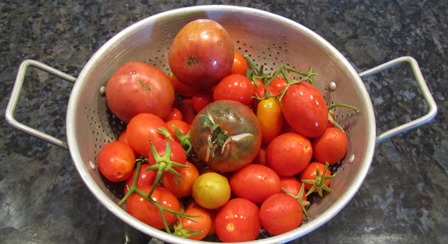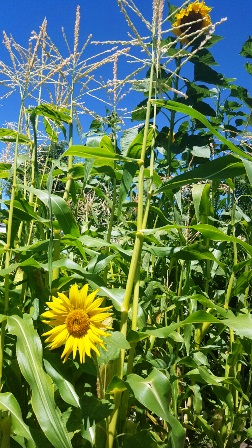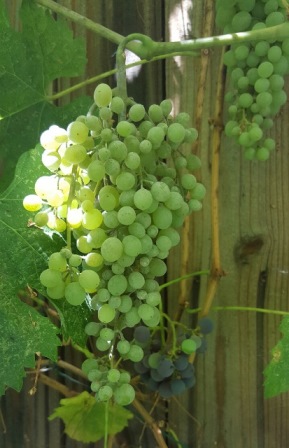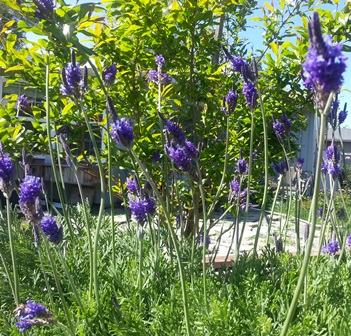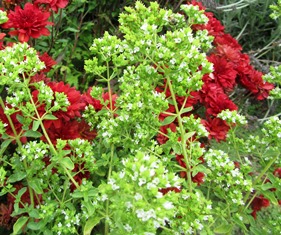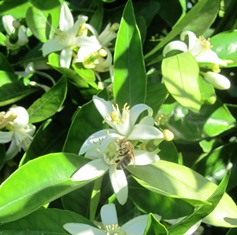What’s Growing in the July Garden?
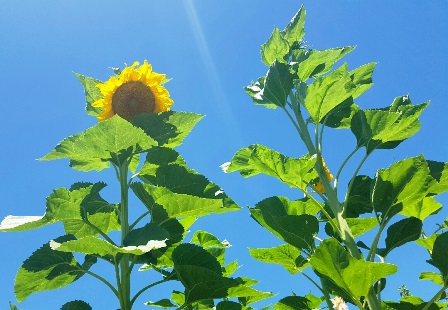
Sunflowers are native to North America and were taken to Europe in the 16th century; however, they date back to roughly 3,000 B.C. Honeybees love sunflowers.
Towering above the squash and lavender in my garden are rows of green corn stalks bearing ears of sweet, plump kernels. Snaking along the rows at the base of the cornstalks are vines laden with butternut squash and Armenian cucumber.
There are ripe tomatoes, too, especially the prolific heirloom–Red Beefsteak. I love cutting up some of these fresh, thin-skin tomatoes and combining them with basil, olive oil, grated cheese, and pine nuts as a topping for pasta. Add some grilled, seasoned chicken and you’ve got a quick and delicious summer lunch.
Zucchini and yellow squash sport large, showy blooms and are producing like crazy this month. While you can harvest and eat the blooms, we prefer the squash. Zucchini is delicious grilled or tossed with rosemary potatoes and onions or made into a French lentil and tomato salad (see recipe from last week’s posting).
Growing on vines trained over a wall and on supports, the green table grapes are beginning to swell. The taste is still a little tart, but will sweeten with the passage of another couple of weeks.
* * *
If you enjoy reading about farmette topics (including gardening, beekeeping, and delicious recipes), check out my cozy mysteries A BEELINE TO MURDER and also THE MURDER OF A QUEEN BEE in the Henny Penny Farmette series (from Kensington Publishing).
These novels are available through online retailers such as Amazon, Barnes & Noble, Kobo Books, and Walmart as well as from traditional bookstores everywhere.
Now available in mass market paperback, this debut novel launched the Henny Penny Farmette series of mysteries and sold out its first press run.
COMING SOON: The second cozy mystery in the Henny Penny Farmette series, available Sept. 29, 2016
Uses of Herbs in Your House and Garden
Herbs in abundance line the shelves of local garden centers now, and for good reason. Many of these versatile plants are hardy and adaptable and have myriad uses in a landscape.
Cooks, especially, appreciate access to culinary herbs near the kitchen. Grow cilantro, parsley, sage, tarragon, chives, basil, anise, dill, mint, and other desirable culinary herbs in boxes or giant pots on a kitchen patio. The location will make it easy to water and gather them.
Many herbs like chives, sage, and dill re-seed themselves, therefore, consider growing these in containers unless you have a designated space in your garden for them.
For shady areas in a landscape or garden, plant sweet woodruff, Borage, and chamomile. In areas that receive full sun, plant rosemary, mother-of-thyme, caraway-scented thyme, and woolly thyme. In areas that remain moist, plant angelica, mints, parsley, and sweet woodruff.
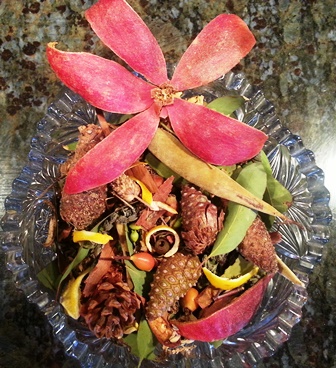
The leathery pomegranate peel takes center stage in this potpourri that utilizes herbs, seed pods, spices, and citrus peels
To grow herbs for potpourris and sachets to scent rooms in your home, cultivate costmary, English woodruff, and lemon-scented herbs like pelargonium and verbena. Also rose geranium and lavender add a lovely scent to mixtures of herbs for potpourri.
With so many different ways to use herbs to beautify a garden or patio and to flavor foods and scent a home, there’s no reason not to grow a few. Remember, herbs (like mint) can be dried for tea or crumbling over salads and you can collect herb seeds or propagate cuttings for next year’s herb garden.
Fern-leaf Lavender Is Easy to Grow and Re-seeds
My hubby brought home several Lavandula multifida plants in five-gallon pots. Also known as Egyptian lavender or Fern-leaf lavender, the plant’s foliage appears fernlike, hence its common name.
The Fern-leaf lavender carries its bluish-purple bloom on three- to five-inch spikes. It’s a pretty plant in the garden, however, its scent is not of lavender as one might expect but rather more like oregano. The foliage is more pungently scented than the buds.
This evergreen perennial is classified as a sub-shrub. In cold climates, the frost kills it. However, it can be grown as an annual. In California and Arizona, the plant blooms from spring through late summer into fall. The blooms are tri-pronged.
These plants reach a height of about 24 inches. They are among the 39 species of lavender that belong to the genus Lavandula in the family of Labiatae (a family which also includes mint, rosemary, thyme, sage, savory, and basil).
The Fern-leaf lavender (like other species of Lavandula) attracts bees, butterflies, and other pollinators. It’s a lovely plant that will provide spectacular color in any garden or around a pool.
For more gardening tips, delicious recipes, farm sayings, and a fun mystery, check out my Henny Penny Farmette series of cozy mysteries, including A BEELINE TO MURDER, and THE MURDER OF A QUEEN BEE.
My books are available on Amazon, Barnesandnoble.com, and other online and traditional bookstores. See, http://www.amazon.com/Beeline-Murder-Henny-Farmette-Mystery/dp/161773909X/ref=sr_1_3?s=books&ie=UTF8&qid=1458077651&sr=1-3&keywords=Meera+Lester
Heirloom Herbs for the Kitchen
The green stalks of the red and yellow onions I planted in late summer are now up about a foot in a raised bed. The garlic that I planted around the same time is also poking up. Having onions, garlic, and fresh culinary herbs available year-round is not impossible in the Bay Area’s mild climate, especially when they are grown in cold frames, protected areas, and raised beds.
Some will re-seed themselves in the growing beds or around your yards. We’ve got Greek oregano and chives growing all over the place. Some of my favorites herbs include basil, cilantro, chervil, chives, dill, fennel, lemon balm, lavender, oregano, mint, marjoram, rosemary, thyme, parsley, sage, and savory.
We also grow a few ornamental herbs such as borage, hyssop, and catnip (for our new kitty), tea herbs (chamomile and mint), and medicinal herbs (like echinacea).
Herbs are easy to grow. Their blooms will attract insects beneficial to the garden. Butterflies and hummingbirds are also attracted. And herbs don’t need much–light, and porous soil, warmth, and decent drainage. For a light feeding of the herbs, we make chicken poop tea. With so many varieties of herbs available, why not tuck a few in your garden or in containers in a protected but sunny and warm area of your patio to enjoy in your culinary creations?
How to Make Homemade Butter
A favorite memory of mine recalls my making butter with my grandmother in her farmhouse kitchen in Boone County, Missouri. All she needed was fresh cream and a jar with a lid.
My grandfather milked the cows and my grandmother would strain the liquid into galvanized cans. After the cream had risen to the top of the milk, she would skim off the cream into smaller cans, storing all of the cans in cool area at the back of the house until my grandfather could take the milk and cream to market. He always kept some back for Rosie’s homemade butter.
The buttermilk that was poured off the would then be chilled. It was his favorite drink after a long, hot day on the tractor working in the fields.
Rosie would hand me a glass jar with a screw top lid in which she’d poured a cup or two of cream and tell me to shake it. My energy and stamina would dictate how long the shaking would have to go on. She’d help. Eventually the butterfat solids and the butter milk would separate.
Rosie favored using a large glass jar with a metal lid that featured a beater and hand crank. Turning the crank beat the cream and amounted to less wear and tear on the arms. Either method worked by separating the liquid from the butterfat.
Today, beating heavy whipping cream (without additives) in a blender or mixer will accomplish the same result. The milk solids eventually become separated from the liquid, which can be poured off. The sweet creamy solid mass can then be salted and even colored if you wish, molded or shaped, chilled, and used. Also, you can leave out the yogurt and still make butter, but it won’t have that tangy flavor.
RECIPE: HOMEMADE CULTURED BUTTER
INGREDIENTS:
1 C heavy whipping cream (no additives)
1 Tablespoon natural, organic yogurt (no additives but with live cultures)
optional: 1/2 teaspoon fine sea salt
DIRECTIONS:
Pour the cream in a small to medium saucepan and warm over low heat to about 90 degrees Fahrenheit.
Stir in yogurt and remove from heat.
Cover and let rest for 24 hours on the kitchen counter to allow the mixture to thicken.
After the cream has thickened, chill in the refrigerator.
Pour chilled mixture into a blender jar or electric mixer bowl.
Beat on a low speed to reduce splatter.
Add salt, if desired.
Beat the liquid and solids separate into massive chunks.
Wrap the butter into a cheesecloth and squeeze over a large bowl to drain out the rest of the liquid. (The buttermilk makes a refreshing drink or can be used to make biscuits).
Mold by pressing the he butter into a plastic mold or an old-fashioned butter molding box. Alternatively, you can shape the butter into small balls using a melon ball scoop.
Hint: To make a flavored butter, add fresh wash, dried, and chopped herbs such as basil and garlic; or cranberries and orange zest. Or, add to the butter apricots or figs (peeled and chopped).
Rooting Plants in Water
I’m a compulsive clipper of plants, knowing that many will send out new roots if placed in a container of water on a window sill. It’s not uncommon for my window sill to fill up with glass jars of cuttings.
With my precious clippings in water, I change the water often to keep it from becoming stagnant.
Among the plants that easily root in water are begonia, coleus, English ivy, geranium, grape ivy, philodendron, pothos, African violet, avocado, and sweet potato.
Several varieties of herbs also root in water: basil, catnip, various kinds of mint, pineapple sage, and watercress.
Bulbs, such as paperwhite narcissus, amaryllis, and hyacinth can be forced to bloom and will also produce roots. Place the base of the bulb on stones or marbles in a dish with water so that the bulb’s base sits on the water’s surface. The roots will grow downward, so you must always ensure there is adequate water.
Take care when putting your cuttings into soil so as not to damage the fragile, newly formed roots. Once you see how easy the process is, you might find your window sill filling up with cuttings in water, too.
Plant Culinary Herbs for Yourself and the Honeybees
During my pre-rainstorm walk today around the farmette, I noticed honeybees foraging for nectar in the last blooms of the cosmos, nasturtiums, and rose geraniums.
This is the time of year that the bees search for autumn pollen and find it in the last flowers of a summer garden, but also in the blooms of lavender, heather, thistle, balsam, and eucalyptus.
In the spring, I planted a large pots of culinary herbs on my patio to use in cooking. The mixture of plants included sage, parsley, marjoram, chives, sweet basil, rosemary, English thyme, Greek oregano, Lebanese mint, chocolate mint, lemon bee balm, spearmint, and French tarragon.
If you enjoy using such herbs in autumn and winter soups, teas, or breads, for example, consider planting pots of herbs to grow on the patio or on a shelf in a garden window or on the window sill. The plants will brighten the cooking area on dreary dark days and, with just a snip, add flavor to your culinary creations.
Grow mint in pots if you don’t want it spreading over your yard. The same is true for the Greek oregano and also English thyme and French tarragon–those plants will grow beautifully even though confined in clay pots, old urns, or even half wine barrels.
In early autumn, there is a diminishing amount of nectar (in blooms) available for the bees. This is the known as the nectar gap–when the sources of nectar for the bees are minimal and new sources have not yet appeared. This time of the year to think about planting for yourself and also the honeybees.
Edible Flowers Add Flavor and A Flourish
Picture a red nasturtium or peppery-tasting marigold displayed around a mound of lemony-yellow butter. Or, imagine the beauty of a handful of sugared purple violets or red rose petals, sans the sour petal base, crowning an iced picnic cake.
During bygone eras when the Romans ruled the world or Queen Victoria reigned during the age named for her, flowers weren’t just for bouquets on the table, they formed an integral part of the food that was consumed.
Many flowers and seeds are poisonous, so it is imperative that you correctly identify any flower or plant you plan to eat or use on food. Also, make sure you are not allergic to the plant before integrating its blooms into your diet.
Several edible florals include the blossoms of herbs such as lavender, dill, garlic chive, coriander, basil, bee balm, marjoram, oregano, anise hyssop, winter savory, summer savory, sage, and mint. Also edible are the flowers of certain varieties of pumpkins, squash, cauliflower, scarlet runner bean, radish, sweet garden pea, and fennel.
Consider also the delicate blooms of society garlic, dianthus, pansy, signet marigold, red clover, African marigold, plum, scented geranium (rose, lemon). You can candy the blossoms of apple and crabapple, but the seeds are poisonous.
Some blooms, such as hibiscus (China rose), mint, rose, and chamomile are used to flavor teas. Lemon blossoms will have a slightly bitter taste whereas orange blossoms are sweet but both are lovely floating in crystal bowls of punch.
Research your chosen plant and correctly identify it before using it in any food preparation. See, http://www.extension.iastate.edu/publications/rg302.pdf
Also see, http://www.ext.colostate.edu/pubs/garden/07237.html
Letting a Plant Go to Seed
Some lettuces, basil, and Greek oregano have spontaneously appeared in my garden. No surprise in that since I let some of my herbs and vegetables go to seed last year.
We used the rototiller on the garden area twice before planting this year. By the time we turned the soil, the vegetables and herbs I had planted last year were a memory. That said, some certainly did re-seed and the evidence of that are the new plants popping up where I didn’t plant them this year.
Open-pollinated vegetable and herb seeds, well tended (meaning, meeting the seed needs of light, water, and good soil), will go through the cycle of sprouting, pushing up through the earth, blooming, bearing, and dying. If you let your plant go to seed and the wind broadcasts the seed or it drops, you will likely (in the case of oregano, basil, chives, and other herbs and some vegetables) get new offspring.
The plant that the mother seed produced will also yield seed (and if you are smart and save some), that seed will repeat the same cycle and the vegetable will also be a true likeness of the original seed. Everything starts with the integrity of the seed.
This is why open-pollinated (OP) seed continue to perform in the same way their ancestors have for hundreds, even thousands of years. And nature’s plant cycles make that possible.
 Facebook
Facebook Goodreads
Goodreads LinkedIn
LinkedIn Meera Lester
Meera Lester Twitter
Twitter






